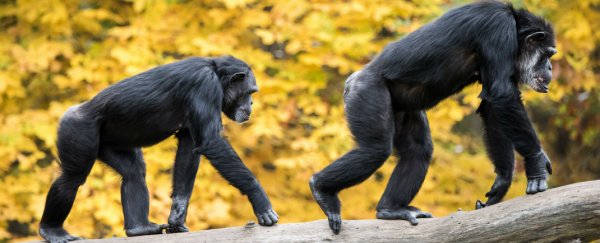If you suffer from lower back pain, your spine might closely resemble that of our nearest ape relative, the chimpanzee, new research suggests.
Our spines have discs of cartilage between the vertebrae, which allow our spines a degree of flexibility, and also play a critical role as shock absorbers when we move around and do anything that's high impact.
But sometimes these discs can slip, or become herniated. This means a small lesion opens up in the fibrous outer layer of the disc, and the inner gelatinous core is able to shift out of place - either moving horizontally, or vertically, into the bone.
These injuries, also known as Schmorl's nodes, can result in some pretty severe back pain, but how and why they occur isn't very well understood.
Previous studies have suggested that the shape of someone's spine could be directly linked to their likelihood of developing Schmorl's nodes.
And because humans display substantially more degenerative and traumatic spinal pain than non-human primates, several different research groups have hypothesised that the cause of this often debilitating injury might be linked to the way we move around: on two feet.
With this theory in mind, researchers from Canada and the UK have conducted a cross-species study of spine shapes, looking at medieval-period human skeletons, and comparing them with the bones of chimpanzees and orangutans, kept in American natural history museums.
The objective was to investigate the relationship between the shapes of the bones making up the spines of each species and their method of locomotion, in order to see disc injuries are more likely to affect individuals with spine shapes closely resembling those of our ape ancestors.
As humans evolved, our vertebrae gradually morphed into shapes that can better handle the stress of walking upright. But, as the researchers point out, "vertebral shape is almost certainly influenced by multiple genes".
This means that within the human species, certain individuals can be expected to have spines that are closer in shape to those of our common ancestor than others. It also means that those people are less adapted for bipedalism.
After comparing the skeletons, the researchers found that healthy spines were distinct in each species, but unhealthy spines in humans - those afflicted with Schmorl's nodes - were statistically indistinguishable from those of chimpanzees. This means they more closely resembled the chimp spines than the healthy human spines.
"Our findings show that the vertebrae of humans with disc problems are closer in shape to those of our closest ape relatives, the chimpanzee, than are the vertebrae of humans without disc problems," archaeologist Mark Collard, from Simon Fraser University in Canada, told the BBC.
"Our study suggests that the pathological vertebrae of some people may be less well adapted for walking upright."
The team's results, which were published in the journal BMC Evolutionary Biology, could help clinicians more accurately predict who's at risk of developing back problems, and could enable better treatment for people with disc injuries.
The researchers also say their work has identified new bone features on human spines that might have helped us transition to walking on two feet.
Source: BBC
